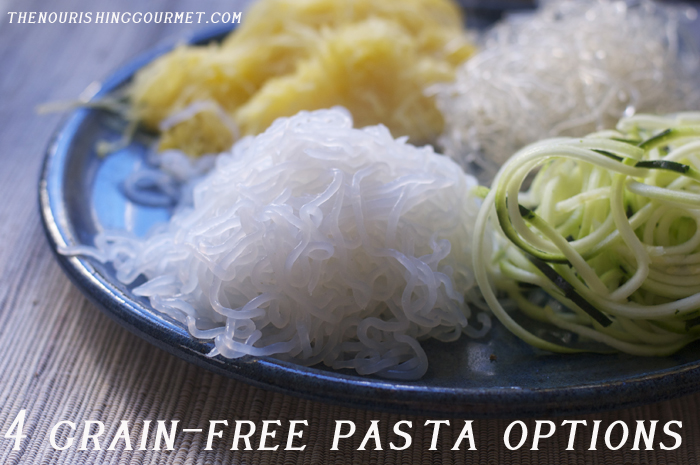
Check out my Le Creuset giveaway going on right now!
If you are grain-free, you might think that your noodle days are over. But don’t be so sure. There are some lovely ways to include “noodles” in your life still! I’ve tried a variety of different options, but never compared them side-by-side, so I thought I’d do that this week and share the results with you all.
I wanted to especially share this with you all now as I shared two delicious and nutrient dense pasta sauces in my new Everyday Nourishing Food edition and wanted those on a grain-free diet to be able to enjoy them as well. One of the things that I am excited about doing with this quarterly publication is writing blog posts that complement it. My blog posts will stand alone (that is, you won’t have to of bought my eBook to enjoy them), but will give further information and recipes built on those shared in the eBook. Like I said before, I am excited about the different ways I can use this format to interact more with you in a variety of ways.
But back to noodles. I used my hearty meat sauce from my eBook that is flavorful, rich, and nutrient-dense and used it with four different grain-free noodles and we sat down to compare them side-by-side. It was actually a pretty fun way to do it! And it gave us more insight as to the strengths and weakness of each noodle option. And by the way, we found that regardless of what type of noodle you use (wheat, gluten-free, or grain-free) the “fill factor” of the dish depends on the sauce. When paired with a super nutrient dense sauce, we found that we felt full and satisfied with smaller servings. I was amazed at the smaller servings of noodles we ate once I started making my more nutrient dense pasta sauce.
Let me introduce you to the four noodles we will be looking at today.
Zucchini noodles, Spaghetti Squash (so aptly named), shirataki noodles, and kelp noodles.
Here they are with my meaty pasta sauce.

Let’s look at them one by one.
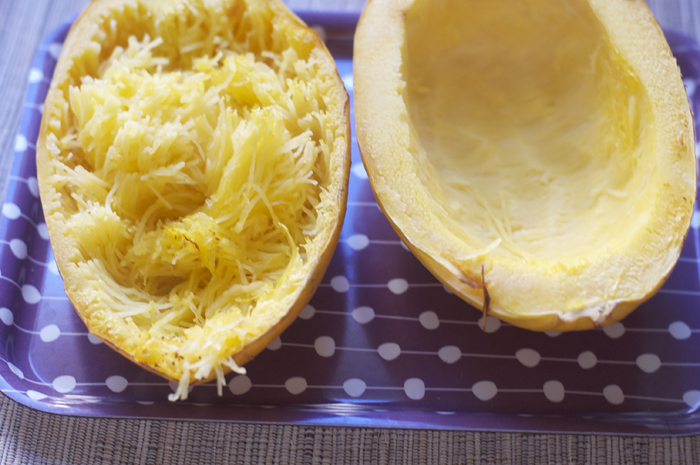
Let’s start with the spaghetti squash. Spaghetti squash is this wonderful winter squash that naturally breaks apart into small noodle –like shreds. We found that as long as you had enough sauce on it, the “squash” flavor didn’t come through much, providing a mild base for the sauce. If you over cook the squash, it will be mushy, but if you under bake it, it can be a little too “al dente”. So, I cooked it until just tender, and then gently simmered the “noodles” in the sauce for a couple of minutes to get it to just the right texture.
Method to make and cook: To cook, preheat the oven to 400F. Cut the spaghetti squash in half, scoop out all seeds and place cut side down on a sheet pan. Pour about ½ a cup of water around the squash and poke both sides a couple of time with a fork to help it cook evenly. Bake for about 30 minutes or so in the oven, or until the squash is soft, but not falling apart soft. Turn the sides around, and use a fork to scrape the squash to make “noodles”. Serve with a wide variety of toppings.
Rating: 1-10, 10 being the highest, 1 the lowest.
Ease: Does have a baking time, though fairly straight to make, 5
Taste: Mild, texture like “angel hair” pasta, 7
Versatility: Can be served many ways, though certain applications (such as noodles in soup) wouldn’t work as well with this option: 6
Texture: 7
Cost: They are fairly cheap at Trader Jo’s last time I checked (though not organic), and can be bought sometimes at Farmer’s Markets for cheap as well. 7
Health-o-meter: Squash is an excellent source of beta-carotene and vitamin C as well as high in antioxidants. 10!
Total Score: 42
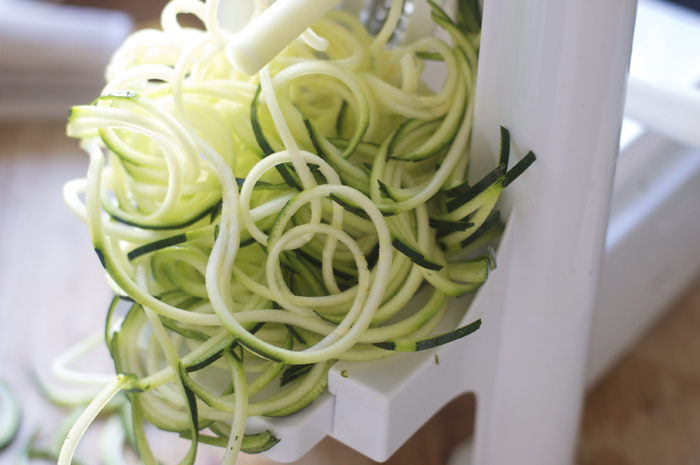 Zucchini noodles are one of the first “grain-free” noodles I made years ago and I have always really enjoyed them. This is probably because I love zucchini. When topped with my meaty pasta sauce, they were delightful and second favorite of my children. How you cook them and for how long will make a difference in texture and will be up to your preference. Both the spaghetti squash noodles and the zucchini noodles seemed to need a little extra salt, as they seemed a little more moist and “watery” in texture upping the need for a salty counterpart.
Zucchini noodles are one of the first “grain-free” noodles I made years ago and I have always really enjoyed them. This is probably because I love zucchini. When topped with my meaty pasta sauce, they were delightful and second favorite of my children. How you cook them and for how long will make a difference in texture and will be up to your preference. Both the spaghetti squash noodles and the zucchini noodles seemed to need a little extra salt, as they seemed a little more moist and “watery” in texture upping the need for a salty counterpart.
Method to make and cook: You can either use a sharp vegetable peeler to “peel” noodles off of zucchini (and then you can cut to desired thickness with a sharp knife), or you can use some sort of “spiralizer:” to make vegetable noodles. I own the World Cuisine Spiral vegetable cutter, and have really enjoyed it. You can make a wide variety of noodles with many different vegetables using it. I’ve wondered about making potato noodles with it, for example. It would be an interesting experiment! . Since I bought mine, another tool, which would probably take a little less cupboard space that has gotten good reviews, is this spiral cutter. The only disadvantage is that you may not be able to use all types of vegetables with it (like root vegetables).
After you have made your zucchini noodles, you can fry them in a little butter, ghee, coconut oil, etc. in a pan or you can boil them in some broth or sauce for a couple of minutes. In this specific taste test, I simmered it gently in the sauce until it reached the texture I liked.
Rating: 1-10, 10 being the highest, 1 the lowest.
Ease: Short cooking time, easy to make if you own a spiral vegetable cutter. 6
Taste: Mild in flavor, 7
Versatility: Can be served many ways, and I love them in soups too! 8
Texture: Although you can certainly overcook them, they tend to hold up well, and I personally like their texture when still slightly firm. 7
Cost: 1 medium squash can make a pile of noodles, making this pretty cost effective, especially during the Summer or if you grow you own. 8
Health-o-meter: Summer squash is a great source of manganese and vitamin C, as well as a source of vitamin A. 10!
Total Score: 46
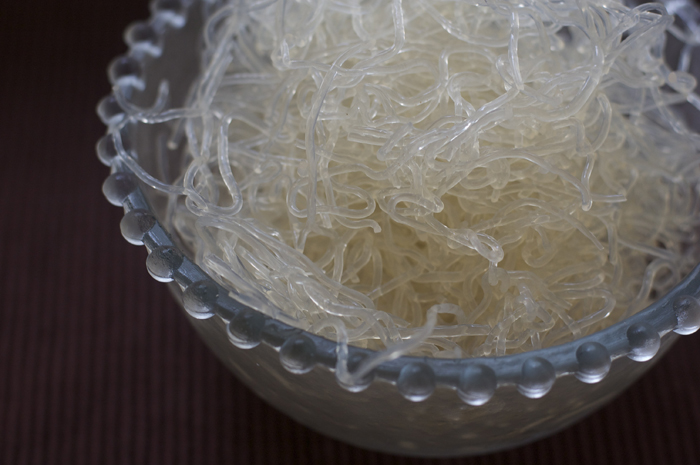 These kelp noodles (brand used above is Sea Tangle) noodles have are made with three ingredients: kelp (a sea vegetable), sodium alginate (sodium salt extracted from a brown seaweed), and water. Kelp is an important source of trace minerals and iodine. Some (such as Dr. Wahls) recommend that you enjoy seaweed in one form or another once a week. Sodium Alginate is a source of sodium and fiber, an ingredient I feel fairly neutral towards. Some people think that it’s not the best ingredient (but these are generally those who think salt is bad for you – a camp I am not in) and others think it could be good for you. I don’t feel strongly one way or another.
These kelp noodles (brand used above is Sea Tangle) noodles have are made with three ingredients: kelp (a sea vegetable), sodium alginate (sodium salt extracted from a brown seaweed), and water. Kelp is an important source of trace minerals and iodine. Some (such as Dr. Wahls) recommend that you enjoy seaweed in one form or another once a week. Sodium Alginate is a source of sodium and fiber, an ingredient I feel fairly neutral towards. Some people think that it’s not the best ingredient (but these are generally those who think salt is bad for you – a camp I am not in) and others think it could be good for you. I don’t feel strongly one way or another.
When topped with my meaty pasta sauce, I enjoyed this noodle the most I ever have. We found that this noodle was the best in bringing out the best flavors of our sauce. However, it also had the biggest texture change from normal pasta. It’s sort of crunchy, sort of “squeaky” when you bite into (in the words of my six-year-old). My six-year-old didn’t want to eat them while my two year old liked them. Joel and I thought it had excellent flavor when paired with this sauce, but the texture was certainly different. I haven’t liked these noodles when paired with less flavorful toppings.
Rating: 1-10, 10 being the highest, 1 the lowest.
Ease: You just need to rinse and they are ready to use. You can top with sauces or use in vegetables rolls raw, or you can top with hot sauce. I simmered mine gently in my sauce. 10
Versatility: May not work in every application as well as it worked with this certain pasta sauce, though I am curious to try them in Asian dishes. 6
Texture: Very different texture – 4
Cost: I spent a little over $3 dollars for a 12-ounce package (which ends up being quite a bit of noodles. You can buy them on Amazon, but your best bet may be trying to find them at an Asian store for the best price. 6
Health-o-meter: A great source of iodine and certain minerals, these could help you consume needed iodine. 9
Total Score: 35
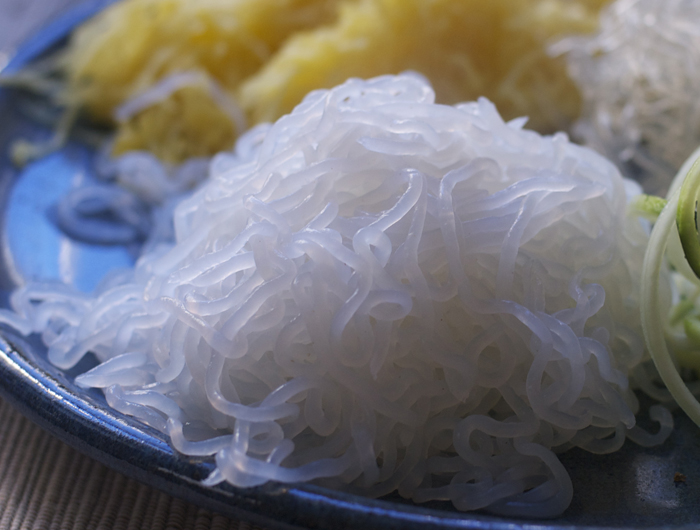
These shirataki Asian noodles are made with a root vegetable, and are sometimes called “yam noodles”. They are made with glucomannan from the vegetable, a soluble fiber which keeps you feeling full for a long time.
It’s important that you don’t buy the Tofu shirataki noodles as they are a source of phytoestrogens and I don’t recommend tofu. These Japanese noodles have been popular in Japan for years, but are just starting to become popular here. It is easy to see why they would be, as these high fiber, no-calorie noodles fit well into our calorie and carb-phobia.
But even if you aren’t part of that phobia, you can see the appeal in these grain-free noodles, as they have a good texture and are very neutral in flavor. We found that when I made an Asian-style tamari based sauce that these noodles were great. With the meaty pasta sauce, they absorbed the flavors of the pasta sauce a little too much, making it not quite as flavorful as the other noodles. However, there texture was so great that they still ended up being a favorite for all of us. They do appear more “processed” than say, my zucchini noodles, and there is some controversy over how much fiber is really good for you, all cautions to keep in mind. However, I haven’t been able to find much wrong with these noodles and many “paleo” eaters don’t have a problem with them either.
Rating: 1-10, 10 being the highest, 1 the lowest.
Ease: You just need to rinse well (they are stinky until you do!) and then simmer for a couple minutes and they are ready to use. 10
Versatility: Works in a wide variety of dishes 8
Texture: 9
Cost: I got mine on sale for $2.50, but they are fairly expensive considering how little each package has. Buying at a local Asian store is definitely your best bet as they generally sell for much cheaper there. Look for “yam noodles” or s Shirataki noodles that don’t contain soy. You can buy the American-catering brand, “Miracle Noodle” online as well. 6
Health-o-meter: There really isn’t that much health benefit to these, so it’s hard to score. I’ll give it a neutral since they don’t seem harmful either. 5
Total Score: 38
In the end, it comes down to personal preference, but hopefully this little review and guide helps you try some new things! I know I haven’t covered every grain-free noodle option, so I’d love to hear your opinion on the above noodles and other grain-free noodle options as well!
* Amazon links include my affiliate information. Thank you for supporting this website!
Latest posts by KimiHarris (see all)
- 2 Ingredient Peppermint Bark - December 21, 2022
- Herbal Hibiscus Lemonade (Keto, THM) - March 16, 2022
- Creamy Curry Red Lentil Soup - December 8, 2021
Be careful with zucchini, there are many GMO versions out there. I try to stick with organic zucchini because of that.
Thanks for bringing up that important issue, Ruth. We always buy organic anyways, but it’s yet another good reason to. My understanding is that gmo zucchini isn’t as widely spread as some of the other crops (like soy), but you can’t really tell when buying nonorganic zucchini, so you should just buy organic. Those wanting more info, here is a link with more information.
Actually the only GMO crops are soy, wheat and corn. Rice is up for modification soon too.
There are a lot more GM crops than you realize. I’m not sure wheat is one but I wouldn’t be surprised. There are GM sugar beets that can be hidden as “sugar” in products. Other crops I can think of off the top of my head are rapeseed (aka canola) and cotton (cottonseed oil is used in food). I’m sure there are more! I buy organic whenever possible.
Hey. I’m a geneticist and on paleo and go for organic foods. But GM foods dont necessarily mean non-organic. You can have a line of hens bred to produce superior eggs but still sold as organic. If you do some research into GM crops youll get a clearer idea of why GM isnt as bad as you think
Actually, if a food is genetically modified it can’t be labeled as organic. 🙂 I think that there can be some confusion between breeding and hybrid seeds and GMOs. I absolutely support traditional breeding methods and hybrid seeds. This link may help.
would be carefull with the shirataki (konjak) noodles to.
they often have calciumhidroxyde added.
There are also bean threads? Have you tried those? Typically they are made from mung beans. They are similarly clear and slightly entertaining as they are almost invisible in water!
I like to overcook spagetti squash, and then squeeze it with a cheesecloth, or dry it in the oven a little bit. When it is drier, it more readily takes on flavors and has less of a water taste. I can even pull off good ol’ cheesey noodles that way 🙂
Awesome tip, Jen! Thanks for sharing! As far as the mung bean noodles, I haven’t tried them (my daughter can’t have most beans) but I bet it would be a great option for Asian dishes. 🙂
But what about the soaking of the beans to make the nutrients available and prevent possible gas and bloating?
We all love bean threads around here – they’re so versatile – but I haven’t really looked into whether it’s truly OK to eat them on a regular basis.
And Rice noodles too… 🙂 Love them.
Rice noodles are awesome, but that’s a grain. lol 😛
My personal preference has always been the spaghetti squash. We were just in Honolulu and we ate at a small drive-in that is frequented by the locals. I ordered a “noodle” dish and was very surprised when I received my order. After viewing your pics and reading the descriptions, I suspect I had the shirataki asian noodles. They weren’t horrible, but I would probably not make them on purpose!
LOL! Could be! However, there are a variety of Asian noodles that they could have used that are similar in appearance.
What makes spaghetti squash your favorite? It’s a favorite of a friend of mine as well. 🙂
I like the system you came up with for scoring the noodles. I like the thought that potatoes would be good as a “noodle”! I bet you could process them in your gizmo and sauté them to a a dente and then top with a great sauce and then add some grated Parmesan. I am hungry already. Thanks for the good ideas. I want the spiral cutter.
Do you know if the kelp noodles and shirataki noodles are GAPS-friendly? I’m thinking I read at some point that the kelp ones aren’t, and maybe the shirataki isn’t either due to the high fiber. Just wondering if you happen to know.
Tara,
Many GAPS people don’t do well with to much fiber, so that could be an issue with the shirataki noodles. You can actually write in to the author for a monthly Q and A (http://gapsdiet.com/FAQs.html) to see. She says that seaweed, fresh or dried, is okay once the introduction diet is done, so maybe the kelp would be considered okay? You’d have to ask though.
I love kelp noodle too, but over here (Toronto, Canada) I can only get one brand, and it comes in a plastic package, so I’m a bit concerned. It’s pricey too – $6.49 for a package (I believe 12oz).
Lan,
Unfortuantely, all of the shirataki and kelp noodles I know of come in plastic wrap. $6.49 is pretty expensive!
In Toronto go to PAT Central in Koreatown. You can get sea tangle noodles along the side wall farthest from the door for a couple dollars. The shirataki noodles are also there if you are interested for around the same price.
I love spaghetti Squash! I haven’t tried shirataki noodles, or kelp noodles yet. The look and texture made me a little nervous. After reading your descriptions, I think I will give them both a try. Thanks for all the great info!
-Erin
great post kimi. i’ve recently begun working with kelp noodles for iodine needs and i find that in coconut milk/asian style dishes, they work best when given some time to soak first. it softens that bitey-crunchy texture. and i don’t have a spiral cutter so i’ve never had zucchini noodles but i’m excited to give them a try! it’s on my wish list! cheersOX
I’ve also used the SeaTangle Kelp Noodles. To soften the noodles just soak them in hot water with one or two Tbsp. of lemon juice for half an hour.
Hey There. I found your blog using msn. This is a very well written
article. I’ll be sure to bookmark it and come back to read more of your useful information. Thanks for the post. I’ll definitely comeback.
Our company Cappello’s makes a tasty almond flour pasta. Everything we do is gluten free and grain free.
Benjamin, where can I find your almond flour pasta? Thanks..
I’ve used the kelp noodles in stir fry before, we loved them. They really soak up the flavor that you are cooking them in. They also get much softer when they are cooked.
My husband really didn’t like the spaghetti squash the first time I made it, so I haven’t tried again. I keep meaning to try the zucchini noodles. Maybe this summer when we have zuch coming out of our ears! 🙂
Spaghetti Squash is my GO-TO! I buy like 15 to 20 pounds every two days! It’s nuts! Ah ahha!
It took me a long time to try spaghetti squash mostly because of having to cut it in half. Someone told me to stick the entire thing in the crock pot on high for 4 hours. That’s it. Sliced in half like a breeze and scooped out the junk and shredded those lovely noodles right out. So easy and perfect!
I stab a knife all the way into the center on four “sides” and then microwave uncovered in a dish for 6 minutes. Turn over and go another 6. Then I evaluate. You can tell it is done when it is squishy on all four “sides.” I let mine cool at least 5 minutes before attempting to handle. Cut in half. Scrape out seeds -gently! Then scrape the rest out of the skin.
Great article! I shared it on Facebook.
Just got some of these and the fettuccine was great. Can’t wait to try the lasagna and ghnocci.
For heavy sauces, like a meat sauce, I like using sweet potato “noodles.” The potato really holds up to the sauce. But zoodles are great for lighter sauces, like pestos.
i love the kelp noodles… if you cook them for a while, they lose the “crunch”.. and are more like a noodle… and sooooooooooooooo easy!!!!!
I LOVE ALL THESE! But I’ve found over the years that each one has a different style…
Spaghetti squash in my opinion is more the pasta like sauce delivery system for shoveling mounds into my mouth.
Zucchini noodles are more like, al dente pasta that you can twirl on a fork like spaghetti or chow mein…
Kelp noodles are fresh feeling, and sort of POP when you bite, and are AMAZING under a stir fry where the veggies are also a little fresh & crunchy.
Then the shiritaki… oh that horrible smelling shiritaki – only at first! It seriously smells like fish. Hold your breath & pop open the pack directly into a strainer under running water. Once they are rinsed they are fine. These to me are a little soggier, and therefore are PERFECT in a soup dish, like Ramen. Actually, treat is like ramen. It’s also good fried up, like Ramen.
I really really really want to try a very firm cucumber in the spiralizer, and then do then do the asian marinated cucumber recipe (that I do all summer long!) served cold as a side dish on a hot summer night. It’s vinegar, sesame oil, and chiles… (and some other stuff, I forget). Seems like a fun take on that dish.
Anyway, i’ve had too much coffee. Bye!
Oh wait, here ya go: http://www.recklessabandoncook.com/2012/04/asian-marinated-cucumbers.html
Also try Miracle Noodle. Made from seaweed/kelp, they mimic pasta noodles without the crunchiness associated with kelp noodles. This product was recommended to me by my holistic doctor a couple of years ago after he suggested I go Paleo. Check out the website for more info: http://www.miraclenoodle.com. We keep several bagged varieties for all our pasta needs.
Where are mung bean noodles? Those are great paleo, gluten free friendly noodles. I think they may actually be vegan too. If you go to your local asian store, you can get them cheap with a good amount per package too!
I love how you write! 🙂 love the rating system, it’s helpful. I can’t make my husband eat the squash versions! I make the kelp noodles and if you Sautee them and boil them long enough, they completely lose that crunch and are pretty close to basic Ramen noodles. I sautéed then with onion and chicken bullion (you can get the vegetarian kind or use a little broth) but then I added carrots and celery and chicken and they are just as satisfying as a big bowl of chicken noodles. I had tried the shirataki ones and disliked that crunch too but I made them with a marinara sauce and didn’t try to cook them long. So they might do as well as the kelp if they’re cooked. Id love to hear more about any other pasta recipes you find 🙂